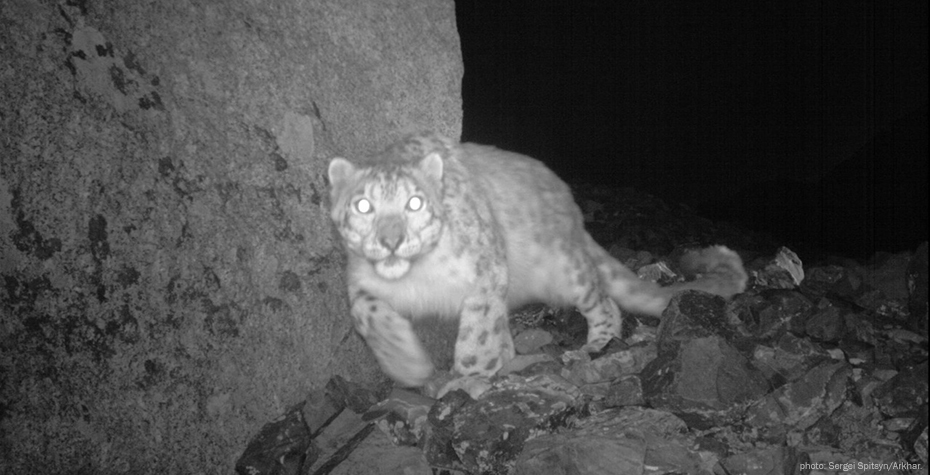Biologist Mimi Kessler ’01 Among First Women to Spot Snow Leopard in Siberia's Altai Region

This summer, biologist Mimi Kessler ’01 became one of the first women to see a snow leopard in the Altai Mountains of southern Siberia. There are believed to be only 30 or 40 snow leopards in the region and only 20 people have reported seeing one before, all of them men.
Kessler is a doctoral candidate at Arizona State University who traveled to Siberia this summer to participate in a wildlife expedition sponsored by conservation organization the Altai Project. The team was hiking in a mountain range in the Altai Republic of Russia, within a kilometer of the Mongolian border.
“We had been led to the location by two experienced snow leopard researchers, Sergei Spitsyn who works with Arkhar and Altaisky State Nature Reserve, and Mikhail Paltsyn who works for WWF-Altai-Sayan, to download images from camera traps they had set a few months previously,” she said. “We were pleased to find that the first camera trap we checked contained images of a snow leopard which had been taken early that very morning.”
According to an Arizona State University press release, Kessler and three other expedition members were taking a water break when she noticed something unusual.
“The first thing I noticed was a pair of pointy ears on top of a ridge less than 200 meters from us,” Kessler told ASU. “Since I work with birds, my first thought was that they might belong to an owl. But on closer inspection, I saw the silhouette of a cat on the ridgetop. We were looking directly at each other. Once I was certain of what I was seeing, I told the rest: 'You are not going to believe this, but there is a snow leopard on that ridge.' My companions grabbed their binoculars, took a look and started yelling with joy. The cat continued to look at us for a few moments, then slowly walked further up the ridge and out of sight.”
"Snow leopards are held sacred by the Altaian people because they live out their lives on mountain peaks, communing with spirits in the heavens,” explained Jennifer Castner, director of the Altai Project and fellow Seven Sisters alumna (Bryn Mawr). There are estimated to be only 90 snow leopards in Russia. “My biologist colleague has studied snow leopards there for 30 years and never seen one with his own eyes. I was humbled and honored by the snow leopard's presence that day."
Mimi Kessler’s interest in Central Asian wildlife first took root during her Wellesley years. Majoring in both Russian area studies and environmental studies, she studied abroad in Uzbekistan in 1999 and in 2001 was a member of the first Wellesley group to study Lake Baikal.
After graduating, Kessler received a Susan Rappaport Knafel '52 Traveling Fellowship to explore the region she had come to love. “I’m extremely grateful for the experiences that fellowship afforded me—by spending the money frugally I was able to spend two years learning about the environment, cultures, history, and languages of Central Asia,” she said. Kessler speaks or understands Russian, Uzbek, Mongolian, Kazakh, Kalmyk, Spanish, and some Altai.
Through the recent Altai expedition, Kessler hoped to learn more about the regional status of the Asian great bustard, the largest bird capable of flight and her study species. “Unfortunately, the results of my observations and conversations in Altai indicate that the great bustard largely disappeared in the 1960s due to overhunting—the last reported sighting was in the 1980s. So, ironically, I was able to find the study species of other team members, but not my own.”
What’s next for Kessler? “I have a lot of data analysis ahead of me, as I write up my team’s multi-year research on the great bustard,” she said. Kessler is also working on a proposal for the Convention on Migratory Species, recommending greater protections for the bustard species. “Reports, presentations, and diplomacy may not be as thrilling as trekking through remote mountain ranges, but in terms of accomplishing conservation goals, they're just as important.”
